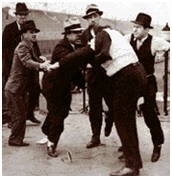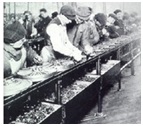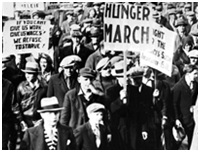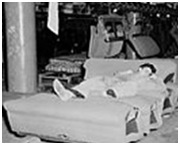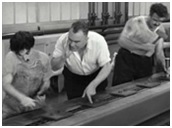|
 |
|
 |
The Battle of the Overpass - Unions and Management
The Battle of the Overpass (1937) Famous for... Four men being beaten up and badly injured on 26th May 1937 (pictured right) by around 40 of the Ford Motor Company’s security men.
Where did it happen? On a pedestrian overpass (or bridge) outside Ford's River Rouge factory, near Detroit, USA.
What were the four victims doing? Distributing to Ford’s workers labour (or trade) union recruitment leaflets (for the car workers’ union, the United Automobile Workers, UAW)
A labour (or trade) union is... An organization that promotes the interests of its members. So its main aim is recognition, the power to negotiate (or jointly decide) its members’ pay and working conditions with employers in a process called collective bargaining. The four injured men wanted Ford to recognize the UAW in this way.
The four men were... (who became leader of the UAW in 1946, pictured right).
Richard Merriweather (who had his back broken). Richard Frankensteen (pictured right).
Ralph Dunham
Their opponents were... Henry Ford (pictured right) Ford’s strongly anti-union founder and boss.
Harry Bennett (pictured right) Ford’s labour relations boss Bennett:
Why the battle was important 1. Bad publicity Photographs of the battle were published nationally and lost Ford public support. Scotty Kilpatrick (pictured right) won the Pulitzer Prize for the photographs.
2. Power Henry Ford and his managers believed in:
a) anti-unionism Ford didn’t want the UAW:
b) F.W. Taylor’s (pictured right) scientific management This is based upon:
This is sometimes called Fordism,
c) autocratic management Telling workers what to do without union interference.
3. Workers’ welfare Ford workers were badly treated – see next section.
Why was work at Ford so bad? 1. Assembly line (pictured right in 1913) Workers had to do boring, repetitive, noisy jobs on the line very quickly (famously caricatured by Charlie Chaplin in his 1936 film, Modern Times). Worst of all, they couldn’t control the line’s speed.
2.Spying Ford hired spies to discover:
3.Stress Strain and anxiety gave workers stomach trouble (called the “Ford Stomach”).
4. Pay In 1914 Henry Ford gave his workers a huge $5 a day. But by 1937 other car manufacturers (like his big rival, General Motors) had caught up.
5. Management Ford’s managers were:
Falling sales of Ford’s Model T led to:
Key events in American labour union history 1806-1922
1806 Commonwealth v. Pullis Court case declaring that unions were illegal (a decision reversed by Commonwealth v. Hunt in 1842).
1877 Railway strike Ended with the help of government troops.
1877 Hanging of ten Irish American coal mining activists in Pennsylvania They were members of the “Molly Maguires”, a secret worker organization.
1886 The Haymarket Bombing Strikers (protesting for an eight hour day) were:
1894 Pullman strike Two month unsuccessful strike by Pullman railway workers, ended by:
1902 Coal strike Gains miners a:
1912 Lawrence textile strike Successful strike (largely by women) in Lawrence, Massachusetts.
1913 Paterson strike A strike by silk industry workers in Paterson, New Jersey, who are starved into submission.
1914 The Ludlow Massacre Striking miners in Ludlow, Colorado, are machine gunned, killing:
1919-20 Steel workers’ strike Unsuccessful strike to win union recognition.
1922 National railway strike Also unsuccessful.
Key union events before the Battle of the Overpass 1932 Ford Hunger March (pictured right) 3,000 hungry protesters (mainly unemployed) attacked by police and Ford’s security guards, near Ford’s River Rouge factory in Detroit . Five were killed and over 60 injured.
1935 The United Automobile Workers union (UAW) founded
1935 The National Labour Relations Act (often called the Wagner Act) Requires employers to negotiate with unions supported by employees.
1936-7 Sit-down strikes at General Motors (pictured right) and Chrysler Forced Ford's two main competitors to negotiate pay and working conditions with the UAW.
What happened after the Battle of the Overpass 1941 A strike at Ford Forces Henry Ford (whose reputation was badly damaged by the battle) to accept and negotiate with the UAW. He was encouraged to do so by his:
1946 Walter Reuther elected as leader of the UAW
1947 Taft-Hartley Act An anti-union law that banned:
1948 Walter Reuther's assassination attempt Reuther was seriously wounded.
1955 AFL-CIO merger Merger of America’s two largest union organizations - the:
1979 UAW membership peaks at 1.5 million
2009 UAW membership at 355,000 Membership drops after the bankruptcies of:
American unions today The percentage of all American employees in unions dropped from
Because of a higher proportion of government union employees, the fall is even more dramatic for businesses - from a third to 7.2%. Why?
1. Globalization Cheap foreign competition that encourages businesses to:
2. Management American companies make unions less attractive by:
3. Decline of manufacturing The old industries where the unions were strong (like rail, steel, coal and cars) have declined. New, expanding industries (e.g. computers and services) are much less unionized.
4. Prosperity People felt they were doing well enough without unions.
5. Automation Machines replacing people.
6. Mafia connections The unions’ image was tarnished by Mafia involvement (particularly in the Teamsters’ Union in the 1950’s).
Key quotes
It was hell in there. - Dave Jones (on working at Ford in the 1930’s).
Unionism, not Fordism - the title of the union leaflet distributed by the four injured men during the Battle of the Overpass.
We expect the men to do what they are told. - Henry Ford.
There is no greater calling to serve your fellow men. There is no greater contribution than to help the weak, Don’t mourn – organize! - Joe Hill, pictured right (American union organizer, just before he was executed in 1915).
In the name of my murdered brother, I call upon you to organize and fight. Long live the workers of the world. - Ben Bussell (brother of Joe Bussell, pictured right, killed at the Ford Hunger March in 1932).
Ford and unions in films
Charlie Chaplin’s Modern Times (1936) Based on Ford’s assembly line (pictured right with Chaplin on the left).
The Grapes of Wrath (1940) Based on John Steinbeck’s book about migrant workers' struggle for survival and union recognition in 1930’s California.
How Green Was My Valley (1941) About life in a Welsh mining village, dominated by the coal mine and the miners’ union. On the Waterfront (1954) Stars Marlon Brando (pictured right), who stands up to the Mafia union thugs in the New York docks.
Billy Elliot (2000) The story of a miner’s son, who becomes a great ballet dancer, is set during the British 1984-5 miners’ strike.
Ford and unions in books
Aldous Huxley’s Brave New World Ford’s philosophy of autocratic management becomes a religion whose:
John Steinbeck’s Grapes of Wrath – see above. |
|
|
||
|
|
|
||
|
||
| Copyright © wisdomtowin.com All Rights Reserved | ||
|

